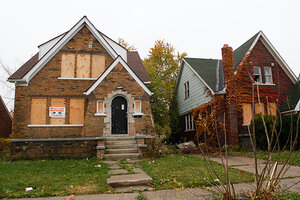Detroit's next step to combat blight: buy and rehab vacant homes
The city will use federal funds to buy and rehab vacant homes in targeted neighborhoods, says Mayor Dave Bing. It's part of a strategy to cope with a shrinking Detroit and to battle blight.

Vacant homes populate a street in downtown Detroit. Of the nearly 400,000 addresses in Detroit, close to 20 percent stand vacant.
Newscom/File
Density is not a problem in Detroit. In fact, the city's populace is spread so thinly that local leaders want people to move closer together, so that public services can be delivered more efficiently and so that neighborhoods are busily vibrant rather than eerily empty.
Detroit took a big step toward that end Thursday, announcing it would use federal funds to try to steer residents into certain neighborhoods – not yet identified – that city planners see as economically and aesthetically viable.
Mayor Dave Bing said he hopes to redirect residents into seven to nine economically stable neighborhoods that have not yet lapsed into full blight. Using the federal money, Detroit will buy and rehab vacant homes in those areas, in a bid to appeal to residents living elsewhere who may be hesitant to move there and to offset the effects of rising unemployment and foreclosures.
“We want to make sure that, before those neighborhoods deteriorate much more, we give them support,” Mayor Bing told the Detroit Free Press.
This is the second phase of the Detroit Works Project, a four-phase plan to reshape the city by removing blighted homes, encouraging entrepreneurship, and addressing its shrinking population. By late 2011, the city plans to craft a final plan, informed by a series of studies and public forums.
The challenge to Detroit stems from the fact that its population has been shrinking – and continues to shrink. During the auto industry's golden years, the city boasted nearly 2 million people. Now the population is not even half that. Bing says the 2010 census will show about 800,000 to 850,000 residents, but the Southeast Michigan Council of Governments says the city is sparser, estimating the remaining population at below 775,000.
Outmigration over the past half century has left Detroit pockmarked with empty land, about 50 miles' worth, or about one-third of the city's total area. About 78,000 vacant homes, or 27 of the total, are within city limits, officials estimate. About 1,700 abandoned homes were razed last year as part of an antiblight initiative. Another 1,300 are expected to be demolished by March.
The consolidation projects are “unprecedented” in the US in their scale and ambition, says Margaret Dewar, a professor of urban and regional planning at the University of Michigan. “The key is how to make it happen so people are treated fairly, have choices, and have a say,” she says.
Despite the acres of blight, some residents living far from the city center have bought up their neighbors' properties and expanded them into mini ranches. “They’ve made their own place a more comfortable place to live and they are caring for the property, which is positive for the city,” says Ms. Dewar.
For these outlying residents, Dewar says, some city services, such as water and sewer, may remain, but other services, such as streetscaping or weekly garbage pickup, may be changed or eliminated.
Dewar says the city is being led by an administration that is finally grasping its plight, a crucial first step to real change. “At long last in Detroit, the attention is turning to the realization we’re not going to fill the place up again with development,” she says.
What kinds of incentives Bing will introduce to entice people to move are not determined, says spokesman Dan Lijana. But the greatest appeal for relocation for residents is a renewed sense of community, he says, especially for people living on the outskirts of the city where the next neighbor may be blocks away.
Besides launching public forums in January to collect citizen feedback, the city is talking with philanthropic organizations, business leaders, and banks “to find creative solutions” to consolidate neighborhoods and strengthen Detroit's economic base, Mr. Lijana says.
“At this point we’re just relatively early in this process, but we’re certainly looking at doing things different than they were done in the past,” he says.
